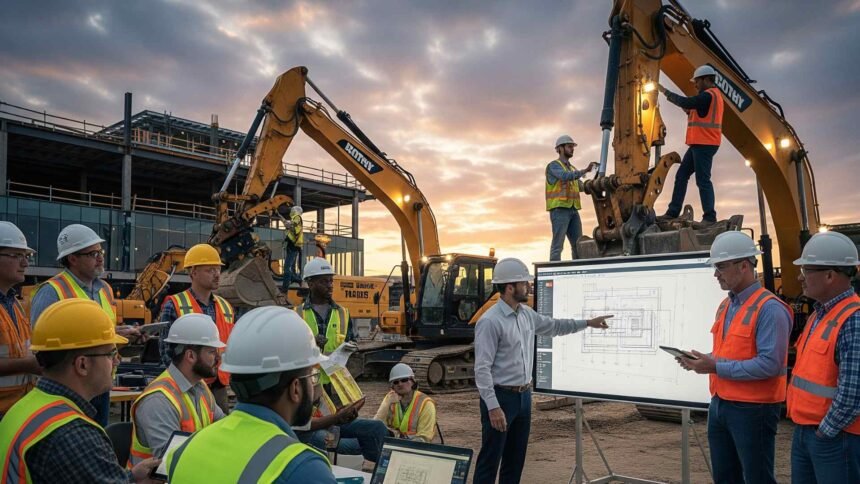Digital construction workforce upskilling
Construction companies across the United States are racing to modernize their operations amid rapid technological advances. As digital tools like artificial intelligence, drones, and building information modeling (BIM) reshape the industry, workers must adapt quickly to stay competitive. Recent reports highlight a pressing need: the sector faces a shortage of over 500,000 skilled workers in 2024, a gap that could widen without targeted training.
The Growing Need for Digital Skills
Industry experts agree that technology drives the future of construction. Contractors now use AI to predict project delays, drones for site surveys, and virtual reality for safety training. A 2025 survey by the Associated General Contractors of America reveals that 59% of contractors worry about the pace of tech adoption, while 44% plan to invest more in digital tools. This shift demands workers who can operate these technologies alongside traditional skills.
Take BIM, for example. This digital modeling software allows teams to visualize projects in 3D, reducing errors and speeding up builds. Yet, many workers lack the training to use it effectively. As one construction manager shared in a recent forum, “Our crews build structures, but now they need to build data too.” Upskilling programs teach these skills through hands-on workshops, blending classroom learning with on-site practice.
The push comes at a critical time. The U.S. economy pledges billions for infrastructure, including AI data centers and renewable energy projects. These require tech-savvy teams. Without upskilling, companies risk falling behind. Deloitte’s 2025 Engineering and Construction Outlook notes a 10% rise in industry value added last year, fueled by digital integration. Workers who master digital tools earn higher wages and enjoy safer jobs, as automation handles risky tasks like heavy lifting.
Current Challenges in the Industry
Despite the urgency, hurdles slow progress. Labor shortages top the list. The industry needs 454,000 more workers by 2025 to meet demand, but retiring baby boomers leave gaps unfilled. Many young people overlook construction careers, favoring office jobs despite AI threats to white-collar roles.
Training access poses another issue. Rural areas lack high-speed internet for online courses, and small firms struggle with training costs. A World Economic Forum report emphasizes that without strong data governance and collaboration, digital transformation stalls. Workers resist change, fearing job loss to machines. One electrician told reporters, “I’ve wired buildings for decades—why learn software now?”
Supply chain delays and economic pressures add strain. Inflation raises material costs, forcing firms to cut training budgets. Yet, ignoring upskilling worsens the problem. HCSS predicts 2025 as a turning point for digital adoption, but only if companies address these barriers head-on.
Innovative Initiatives and Programs
Forward-thinking organizations step up with solutions. The Home Depot Foundation invests $50 million to train 20,000 tradespeople by 2028, focusing on digital skills like augmented reality for on-site guidance. Apprenticeships surge, with the U.S. Department of Labor promoting programs that combine paid work with tech education.
San Diego State University launches new courses integrating AI and robotics into construction curricula, preparing students for real-world challenges. Google supports training 100,000 electrical workers and 30,000 apprentices, aiming to boost the talent pipeline by 70% in five years. These efforts attract Gen Z, who see trades as secure amid AI disruptions. Enrollment in community college trade programs hits records, up 64% since 2012.
Trimble offers free resources like online tutorials for software tools, helping workers upskill at their own pace. Public-private partnerships, such as those from the EU-inspired Pact for Skills, adapt to U.S. needs by focusing on green and digital training. Companies like hh2 Cloud Services push HR teams to use digital platforms for talent management, easing recruitment. These programs fill jobs and empower workers, as one apprentice noted: “Learning VR changed how I see my career.”
Benefits and Future Outlook
Upskilling yields clear wins. Firms embracing tech win more bids, boost revenue, and attract top talent. Projects finish faster, with fewer accidents—safety improves 20% through digital monitoring. Workers gain confidence and higher pay, reducing turnover.
Looking ahead, the industry thrives on innovation. By 2030, AI could automate routine tasks, freeing humans for creative roles. As Mike Rowe warns, the workforce shortage threatens progress, but upskilling bridges the gap. With investments flowing, the U.S. construction sector positions itself as a digital leader, building a stronger economy for all.









